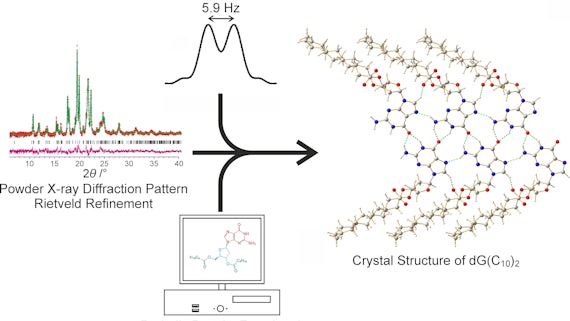Novel experimental strategy elucidates complex crystal structure
25 Mai 2017

Researchers have used a combined powder XRD, solid-state NMR and computational approach to determine the structure of 3',5'-bis-O-decanoyl-2'-deoxyguanosine.
A combination of experimental and computational methods has enabled researchers to establish the structure of one of the most challenging organic materials than has been determined to date based on the analysis of powder X-ray diffraction (XRD) data. However, using only powder XRD data, the crystal structure of the 90-atom molecule 3',5'-bis-O-decanoyl-2'-deoxyguanosine [denoted dG(C10)2] is challenging to determine due to its size and complexity, which makes the structure determination process particularly complicated.
Reporting in the journal Chemical Science, researchers led by Professor Kenneth Harris from Cardiff University’s School of Chemistry (in collaboration with Professor Steven Brown at the University of Warwick and Professor Stefano Masiero at the University of Bologna) augmented the powder XRD analysis of dG(C10)2 with information derived from solid-state nuclear magnetic resonance (NMR) data and dispersion-corrected periodic density functional theory (DFT) calculations for structure optimization. This combined approach using experimental and computational methodologies enabled the team to successfully establish that dG(C10)2 forms a hydrogen-bonded guanine ribbon motif that has not been observed previously for 2'-deoxyguanosine derivatives.
The dG(C10)2 molecule is currently used in photoelectric devices, including photoconductive materials, biphotonic quantum dots and photodetectors with rectifying properties. In all these applications, the structural arrangement of the guanine groups is a key factor. It has therefore been particularly important to understand the preferred structural properties of dG(C10)2 in the solid state.
It is anticipated that the synergy of experimental and computational methodologies used in this research will become an essential feature of strategies to further expand the application of powder XRD as a technique for structure determination of organic molecular materials of even greater complexity in the future.
